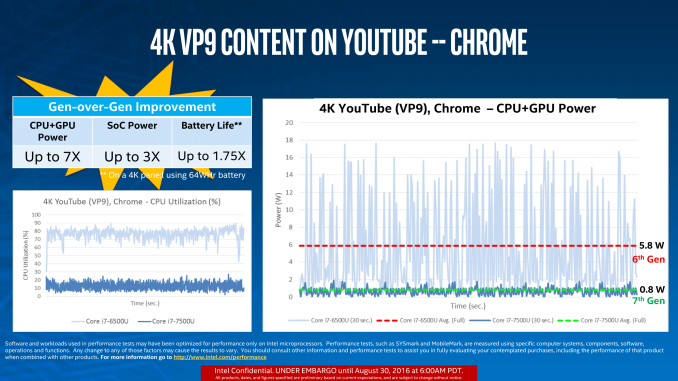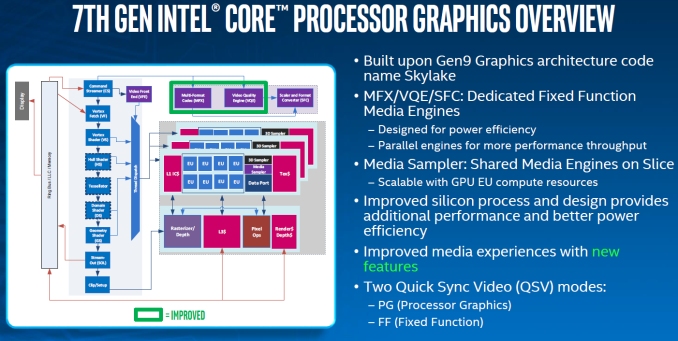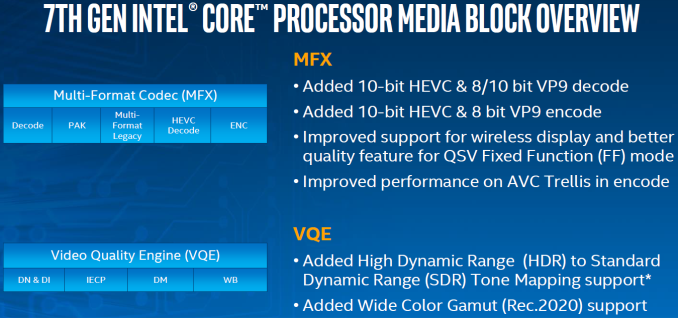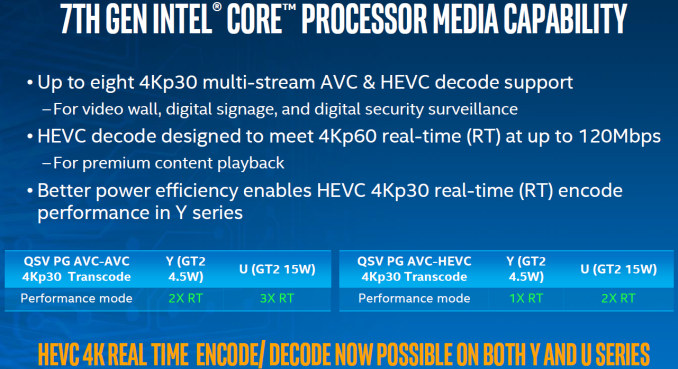Intel Announces 7th Gen Kaby Lake: 14nm PLUS, Six Notebook SKUs, Desktop coming in January
by Ganesh T S & Ian Cutress on August 30, 2016 9:00 AM EST- Posted in
- CPUs
- Intel
- 14nm
- Kaby Lake
- Gen 9
- Speed Shift
- Turbo Boost
The Kaby Lake-U/Y GPU - Media Capabilities
While from a feature standpoint Kaby Lake is not a massive shift from Skylake, when it comes to GPU matters it none the less brings across some improvements that are directly visible to the end-user. As with the CPU cores, Intel’s 14nm+ process will allow for higher GPU frequencies and overall better GPU performance, but arguably the more impressive change with Kaby Lake is the updated media capabilities. To be clear, Kaby Lake is still an Intel Gen9 GPU – the core GPU architecture has not changed – but Intel has revised the video processing blocks to add further functionality and improve their performance for Kaby Lake.
The media capabilities of the Skylake GPU was analyzed in great detail in our 2015 IDF coverage. The updates to Kaby Lake-U/Y should be analyzed while keeping those features in mind. The major feature change in the Kaby Lake-U/Y media engine is the availability of full hardware acceleration for encode and decode of 4K HEVC Main10 profile videos. This is in contrast to Skylake, which can support HEVC Main10 decode up to 4Kp30, but does so using a “hybrid” process that spreads out the workload over the CPU, the GPU’s media processors, and the GPU’s shader cores. As a result, not only can Kaby Lake process more HEVC profiles in fixed function hardware than before, but it can do so at a fraction of the power and with much better throughput.
Also along these lines, Kaby Lake has implemented full fixed function 8-bit encode and 8/10-bit decode support for Google’s VP9 codec. Skylake offered hybrid decode support for the codec, which is useful from a feature standpoint, but is a bit more problematic in real-world use since it’s not as power-efficient to use VP9 a codec implemented in fixed function hardware. Google has proven eager to serve up VP9 to its YouTube users, so they can now much more efficiently decode the codec. Meanwhile, on the encode side, brand-new to Kaby Lake is VP9 encoding support, to go with the aforementioned HEVC encode support.
| Intel Video Codec Support | |||||
| Kaby Lake | Skylake | Broadwell | |||
| H.264 Decode | Hardware | Hardware | Hardware | ||
| HEVC Main Decode | Hardware | Hardware | Hybrid | ||
| HEVC Main10 Decode | Hardware | Hybrid | No | ||
| VP9 8-Bit Decode | Hardware | Hybrid | Hybrid | ||
| VP9 10-Bit Decode | Hardware | No | No | ||
| H.264 Encode | FF & PG-Mode | FF & PG-Mode | PG-Mode | ||
| HEVC Main Encode | FF & PG-Mode | PG-Mode | No | ||
| HEVC Main10 Encode | FF & PG-Mode | No | No | ||
| VP9 8-Bit Encode | FF & PG-Mode | No | No | ||
| VP9 10-Bit Encode | No | No | No | ||
An overview of the GPU engine in Kaby Lake-U/Y is presented in the slide below.
The new circuitry for hardware accelerating HEVC Main10 and VP9 are part of the MFX block. The MFX block can now handle 8b/10b HEVC and VP9 decode and 10b HEVC / 8b VP9 encode. The QuickSync block also gets a few updates to improve quality further, and AVC encode performance also receives a boost.
The Video Quality Engine also receives some tweaks for HDR and Wide Color Gamut (Rec.2020) support. Skylake's VQE brought in RAW image processing support with a 16-bit image pipeline for selected filters. While Intel has not discussed the exact updates that enable Rec.2020 support, we suspect that more components in the VQE can now handle higher bit-widths. Intel pointed out that the HDR capabilities involve usage of both the VQE and the EUs in the GPU. So, there is still scope for further hardware acceleration and lower power consumption in this particular use-case.
Intel claims that Kaby Lake-U/Y can handle up to eight 4Kp30 AVC and HEVC decodes simultaneously. HEVC decode support is rated at 4Kp60 up to 120 Mbps (especially helpful for premium content playback and Ultra HD Blu-ray). With Kaby Lake-U/Y's process improvements, even the 4.5W TDP Y-series processors can handle real-time HEVC 4Kp30 encode.
On the subject of premium content, in their presentation Intel rather explicitly mentioned that the improved decode capabilities were, in part, for “premium content playback.” When we pushed Intel a bit on the matter – and specifically on 4K Netflix support – they didn’t have much to say beyond the fact that to play 4K Netflix, you need certification. Based on what was said and what was not said (and what we know about the certification process) our educated guess is that the updates in Kaby Lake-U/Y include some new DRM requirements for 4K content, and 4K Netflix should hopefully be good to go with the new platform. However on that note, because of those DRM requirements and that this is being pitched as a new feature for Kaby Lake, we suspect that when 4K Netflix streaming does come to the PC platform, Skylake owners are going to be out of luck.
Update: On a related note, one of the Intel press releases that has gone out today is that Sony's 4K movie and television streaming service, ULTRA, will be coming to Kaby Lake PCs in 2017. To date the service has only been available on Sony's televisions - in part for security reasons - so this is an example of one such premium content service that's coming to Kaby Lake thanks to its stronger DRM abilities.
It must be kept in mind that all the encode / decode aspects discussed above are for 4:2:0 streams. This is definitely acceptable for consumer applications, as even Blu-ray video streams (that have plenty of bandwidth at their disposal) are encoded in 4:2:0. However, if Intel wants to use the new media engine in professional broadcast and datacenter applications, 4:2:2, and, to a much lesser extent, even 4:4:4 support might become necessary. For the purpose of the Kaby Lake-U/Y consumer platforms being introduced today, this is not an issue at all.
Moving on, like the GPU core itself, Kaby Lake-U/Y's display pipeline is the same as that of Skylake. This means the iGPU can support up to three simultaneous displays.

One of the disappointing aspects from Skylake that has still not been addressed in Kaby Lake-U/Y is the absence of a native HDMI 2.0 port with HDCP 2.2 support. Intel has been advocating the addition of an LSPCon (Level Shifter - Protocol Converter) in the DP 1.2 path. This approach has been used in multiple motherboards and even SFF PCs like the Intel Skull Canyon NUC (NUC6i7KYK) and the ASRock Beebox-S series. Hopefully, future iterations of Kaby Lake (such as the desktop and high-performance mobile parts coming in January) address this issue to simplify BOM cost for system vendors.
In summary, Kaby Lake-U/Y resolves one of the major complaints we had about Skylake's media engine: the absence of hardware-accelerated 4Kp60 HEVC Main10 decode. There are a few other improvements under the hood that enable a more satisfying multimedia experience for consumers. The software and content-delivery ecosystems have plenty of catching up to do when it comes to taking full advantage of Kaby Lake-U/Y's media capabilities.














129 Comments
View All Comments
Arbie - Tuesday, August 30, 2016 - link
How did we get to 7 pages of comments and no flame war yet? Who's not here?fanofanand - Tuesday, August 30, 2016 - link
Vlad and ddriver. Once they get here all hell will break loose like usual.th3z3r0 - Tuesday, August 30, 2016 - link
Seems like a decent upgrade for notebooks and for 4k videos.http://www.notebookcheck.net/Kaby-Lake-Core-i7-750...
MrSpadge - Tuesday, August 30, 2016 - link
"We are told that transistor density has not changed, but unless there’s a lot of spare unused silicon in the die for the wider pitch to spread, it seems questionable."With the taller fins they're increasing the drive current which each fin provides. A transistor uses several fins, depending on how much current it has to drive. By using taller fins Intel can get away with fewer of them and hence can place them further apart and reach the same transistor density.
negusp - Tuesday, August 30, 2016 - link
Doh! There goes my hopes for proper Skylake support on linux.Morawka - Tuesday, August 30, 2016 - link
ok so lots of marketing BS in this article, not anand's fault, rather intel's.So what i'm seeing is virtually no IPC improvements, not even 1-2%, all gains are coming from optimized max turbo clockspeeds. GPU is what see's the majority of the improvements, however there are a few fixed function blocks on the CPU that are new for VP9.
Intel is doing mobile first yet again. I dont blame them, those mobile chips are waay overpriced and have the most profit margin. $300 core M CPU anyone?!?!, or how about a $450 quad core mobile i7. Yeah same ol tricks coming from intel. Won't be long before intel is irrelevant, i'd say within 10 years, mostly due to AMD's recent IPC gains and ARM taking a bigger part of the market if the Intel Fabbed Apple iPhone Chips rumors pann out. Some say apple will move all their mobile to arm, and they will all be fully custom by apple, but made by 10nm and 7nm intel foundries.
zodiacfml - Tuesday, August 30, 2016 - link
I disagree on most points but I have to agree with you with Intel's current strategy. I know they can release the 10nm parts this year. It might painful and expensive and works for the near-term, but as ARM continues to build bigger and faster parts, the gap is becoming smaller throughout the years.Next thing they'll know (Intel), people will start using PCs based on ARM. Microsoft's strategy of releasing and maintaining an ARM based OS (Windows phone) wasn't bad as it looks now. Intel is ignoring the mainstream/consumer market who funds the R&D and tools required for the lucrative products in the server/enterprise market.
Meteor2 - Wednesday, August 31, 2016 - link
Well, Windows on ARM didn't work out (RT), unlike Android on x86, which is good. But maybe with UWP Microsoft will have another go -- they've opened pathways to get legacy software on to UWP, which would enable processing on ARM.tobi1449 - Tuesday, September 6, 2016 - link
No it doesn't. Full UWP-Apps will run on any platform, but legacy software (i.e. x86 software) that has just been packed as UWP App (so it can be sold via the Windows Store) won't be able to run on anything but x86 platforms.Cliff34 - Tuesday, August 30, 2016 - link
For me, looking to buy a new laptop end of this year, is hoping that this will drive Skylake laptops prices down further. However given that Kaby Lake is probably releasing to retail Q1 next year, I don't think I will see much in that beyond the savings from the holiday pricing.